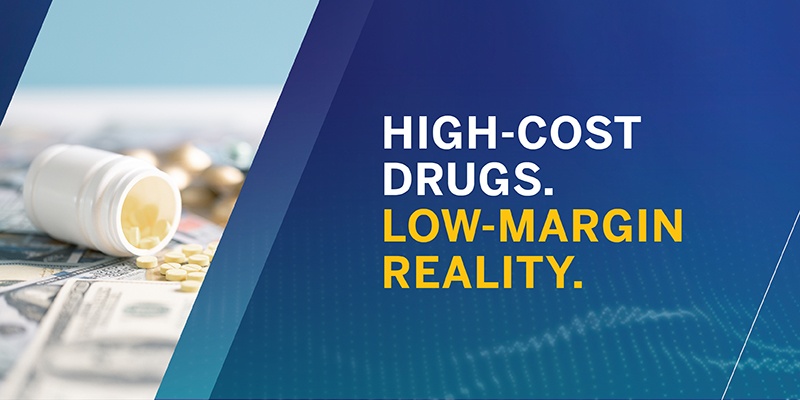
By: Paige Ivey, Sr. Director, Healthcare
In the ever-evolving landscape of American healthcare, specialty pharmacies are a bright spot — innovative, patient-centered, and essential to managing complex, chronic, and rare conditions. But behind the scenes, many of these pharmacies are walking a financial tightrope, juggling delayed payments, high drug costs, and patchy access to the safety nets that keep their doors open.
At the heart of the challenge is receivables management. Specialty pharmacies don’t stock shelves of $12 antibiotics. They handle injectable biologics, gene therapies, and oral oncology drugs — treatments that can cost $10,000 or more per prescription. Each transaction is a high-stakes bet that the money will come in before the pharmacy runs out of cash to cover the next one.
It’s not just patients who pay. Manufacturer copay cards, foundations, and government programs all help offset the astronomical costs, especially for patients who can’t afford their share. But those payments don’t hit the books immediately. Reimbursement can be slow and staggered, trickling in from multiple directions over weeks — or months. Meanwhile, the drugs are already dispensed, and the pharmacy is out tens or hundreds of thousands of dollars.
This dynamic is becoming harder to sustain as specialty drug costs continue to rise. In 2021, the average annual cost for a specialty drug reached $84,442. At that time, Nephron Research projected total annual U.S. specialty drug spending would hit $375 billion by 2025. But newer estimates suggest they undershot: the healthcare industry now expects this year’s total U.S. specialty spend to reach $485 billion — a forecast that illustrates how dramatically the cost burden is accelerating. And with around 75% of new drug approvals now falling into the “specialty” category, that burden is unlikely to ease anytime soon.
To stay afloat, a specialty pharmacy must have serious working capital or a line of credit big enough to handle the gap. That’s a barrier to entry for independent pharmacies and small chains hoping to serve their communities with specialty care. And when the financial burden becomes too great, some pharmacies exit the space altogether — shrinking patient access to life-changing medications. This is especially true in rural and underserved areas, where specialty pharmacies often serve as a critical point of care for patients with limited provider options.
For those that qualify for the federal 340B program, margins are more forgiving. These entities — usually hospital-owned or affiliated — can purchase drugs at steep discounts and bill insurers at standard rates, creating a buffer that can absorb some of the delay in payments. But 340B qualification is far from universal, and independent specialty pharmacies don’t always have the institutional partnerships required to get in.
The result is a fragmented system where some pharmacies have the financial scaffolding to survive, and others are stuck in a cash-flow crunch that threatens their existence. In Alabama, for example, dozens of independent pharmacies have shut down over the past two years, with some pharmacists reporting losses on about 20% of prescriptions because of inadequate reimbursement rates. This isn’t just a business problem — it’s a patient access problem. When pharmacies can’t afford to float the cost of treatment, patients are left waiting, switching providers, or facing unnecessary interruptions in therapy.
Addressing this problem will take more than piecemeal fixes. Policymakers and payers need to pursue a coordinated strategy that reflects the financial realities of specialty pharmacy. That starts with faster reimbursement timelines — especially for third-party support like copay cards and foundations — and continues with a serious effort to reduce the administrative complexity that slows payment down. Expanding access to programs like 340B, particularly for independent pharmacies in underserved areas, would help shore up access where it’s most at risk.
But no solution will be complete without tackling the role of pharmacy benefit managers. Recent state-level legislation has attempted to curb PBM practices — like spread pricing and delayed reimbursements — including Alabama, which reacted to those losses and closures by passing the Community Pharmacy Relief Act back in April. But federal action will be needed to ensure consistency and long-term impact. The current PBM reimbursement model was built for generics and volume, not high-cost, low-volume specialty drugs. It’s a mismatch that creates instability at best — and, at worst, drives providers out of the space entirely. Greater transparency, oversight, and structural reform of PBM practices are critical if specialty pharmacies are going to keep doing what they do best: delivering targeted, often life-saving care to the patients who need it most.
The promise of specialty pharmacy is clear. But without changes to the way we pay for and support it, that promise risks becoming unsustainable. We can’t afford for the most innovative corner of pharmacy — where patients with chronic diseases and rare cancers find tailored, life-altering therapies — to be the most financially vulnerable. The good news is, with the appropriate support, we can preserve what makes specialty pharmacy so effective and ensure it remains a vital, accessible part of the healthcare system for years to come.
